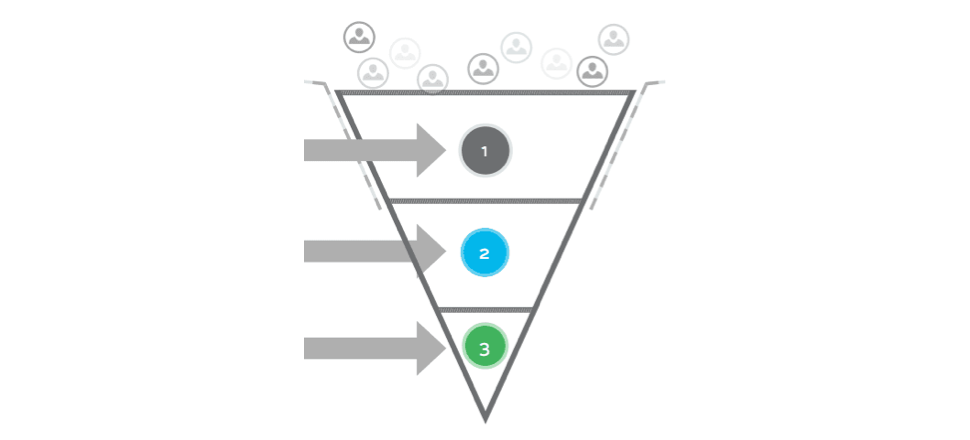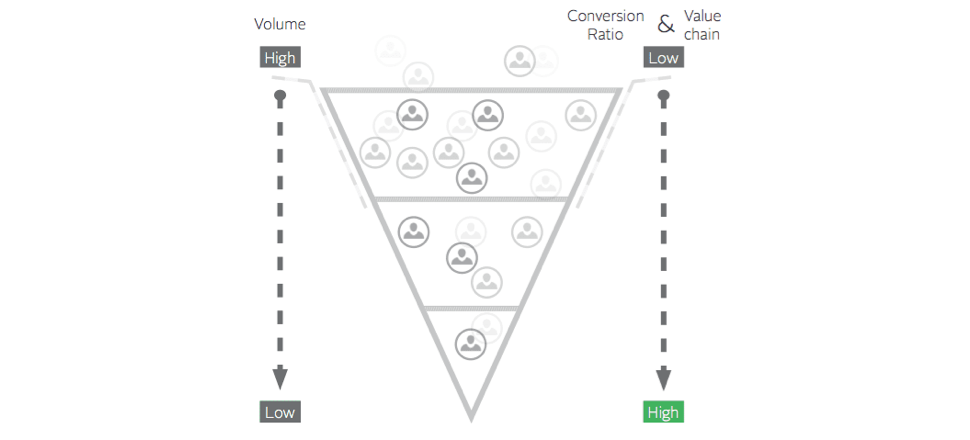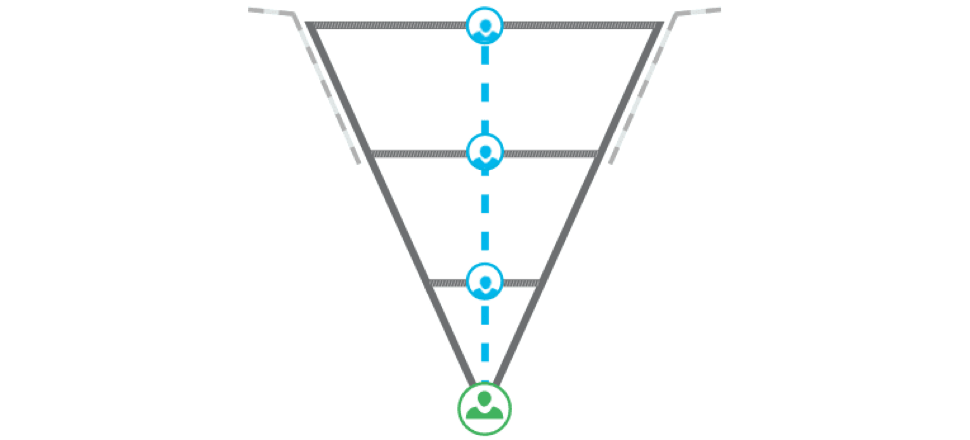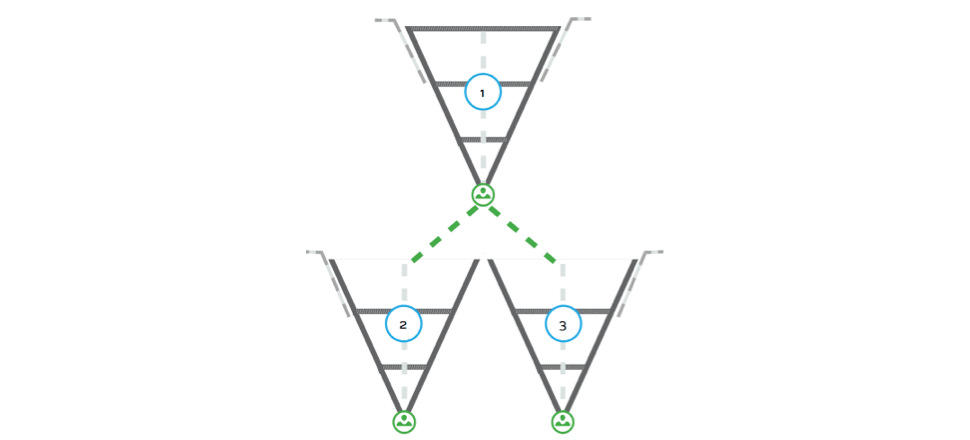Product
Strategy
Strategy
During our webinars we spend a lot of time on advising our attendees about their Facebook & Instagram advertising strategies. One of the things we keep getting questions about is how to target the right audience by creating a funnel.
During our webinars we spend a lot of time on advising our attendees about their Facebook & Instagram advertising strategies. One of the things we keep getting questions about is how to target the right audience by creating a funnel. We have noticed that we need to give more information about how to target the right audience for your Facebook & Instagram Ad campaigns.
Building a funnel is the key to a successful campaign. Not only for your Instagram and Facebook campaigns but for all your marketing campaigns. It’s about targeting the right audience with relevant content so you can convert people who are unaware of your brand into paying customers or any other desired goal.
Let’s quickly grab the basics. A funnel looks like a upside-down pyramid with different layers. There are a lot different setups but in this blog we will use a basic three layered funnel.

Potential customers who are not aware of your company but are potentially interested in your products or services
People who are aware of your company but currently don’t have any actual need for your products or services
People who are aware of your company and currently looking for your products and services
Now you know what a funnel looks like it’s time to explain how it works. Just by looking at the Facebook & Instagram audience funnel you could have guessed it has something to do with volume. You’re right about that, and it’s one of the most important things to know.

The first layer of people who are not aware are the largest group. This could literally be anyone in the world. However, targeting everyone in the world is very expensive and will not help you at all, so we’ll learn you how to break that into pieces you can work with.
The bottom layer with the lowest volume has the highest conversion rates. That same group also carries the highest value or Return on Ad Spend (ROAS) as we call it.
The big secret about building a funnel is creating personas. Personas are the building blocks of your funnel. Create personas for every layer in your advertising funnel. A persona is a group of people who share the same behavior, these personas define who your audience is. A persona could be all pregnant women between 25 & 35 who are living in Amsterdam and want to buy baby clothes.
The first layer, people who are not aware, is the most time consuming to prepare. We’ll have to think carefully what the answer is to this question:
‘How do people potentially interested in my product look like and behave?’
Think about everything: where do they live, what age they have, what interests them, women or men, which brands or products do they already have or buy? Another great source of Persona X is your own existing customer base. Use an export of email addresses or mobile numbers to create a Look a Like audience.
You’ll have to find the people who already know you. Facebook & Instagram offer two easy tools to build Persona Y: Custom Audiences & Page fans. You can use your existing customers to create a Custom Audience. Secondly you can use your page fans.
Facebook’s custom audience tool is very powerful and supports far more options then just emails. Here is the complete list:
Welcome to the last stop before conversion! This is your low hanging fruit here. These are the people who are aware of your company and are currently looking around to buy a product or services like yours. Facebook has excellent tools to reach out to these direct leads.
The first and most used tool is called Website Custom Audience. By implementing a Facebook Custom Audience pixel on your website, Facebook can track the pages users view and retarget those users when they’re on Facebook or Instagram.
Product Audience is similar to WCA as in that you can also retarget users but this time the users are indexed using a list of all your products in your catalog and Facebook keeps a log of which products they’ve viewed. Using a product audience, you can show customers similar products based on the ones they’ve already viewed.
By using these two tools you can target people who are at this very moment looking around and considering to buy a product from your company. Needless to say that this is a very important group and has a huge potential value. Big difference with Persona X is that this audience has a much lower volume. Which again makes sense. The good thing is that you won’t be needing huge budgets to target them.
Relevancy is the match between what your are trying to tell your audience and what your audience wants to hear. Relevancy is really important because in a split second it triggers your audience to pay attention to what you are trying to sell through your ads. The key to relevancy is to know who’s your audience.
Desire is the second important ingredient, because who doesn’t want to optimse their Facebook and Instagram budget campaigns without lifting a finger? Everybody! You see what I did right there? You want to show your audience something they want, something they need, something they desire. You can talk about plain USP’s here, but you can also try to talk about feelings.
Exclusivity is the third important ingredient. Because after you have presented a relevant ad which matches the desire of your audience a potential customer could still say: Why should I buy this product from you and not from your competitors? You need to create exclusivity so the potential customer wants to stick with you.
Urgency is the last optional ingredient. You don’t always have to use urgency but in the right moment it could be a great call to action and animmediate lead generator. For example: this is a limit time offer, you have to claim it before twelve o’clock.

With your funnel blue prints and ad creatives in place, you’re now ready to publish your campaign! You can’t be better prepared than this. As soon as it is running you can’t just let it run unattended (unless you’re using TNA’s hyper optimisation which does all of these steps automatically).
I use the bottom up optimisation approach which means that we start optimising at ad level. The reason for doing this is that sometimes some ads inside an audience are performing really bad and are pulling the average down. Just by switching these ads off often leads to an improvement for the audience’s average. Use this 3 step plan to get the most of any campaign.
As said before don’t start with just one ad. Run multiple creatives and test them all. If you are doing this manually make sure to run a maximum of one or two ads at the same time per audience. Rotate these with other variations based on time, for example every day another set of variations. (Alter this strategy to your own liking and situation) Soon enough you’ll see which ads are performing best. Turn these back on when you have tested all your variations and optionally create new ones based on your learnings so far.
Like most advertisers your budget is probably limited. So you want to invest it as good as 1 possible right? You can start off by assigning each audiences a proportional piece of your
total budget. Take into account the size of your audience to achieve this. Now when your
campaign is running you’ll notice that some audiences are simply outperforming others.
If you can get more results by increasing the budget of one audience by lowering the budget of another, go ahead and test it out. Continue this during your campaign to find the best investment possible.
After some time of running and optimising your campaign you’ll want to open up your reporting tool and start making breakdowns to see where you’re results are coming from. Breakdowns are a great way to literally break down your general campaign statistics in smaller pieces to see where your results are exactly coming from. Use breakdowns like: gender, placement, age and device. Using these will show you were your sweet spot is. Use these learning to create new versions of your audiences for even better results and keep digging to get the most out of any campaign. Sometimes it is good to do this in a new version of your campaign as a completely new test. This allows you to compare different versions of your campaign later.

Open Targeting
Most basic form of targeting in Facebook. You can build audiences based on country, language, gender, age, interests and all kinds of other cool filters
This is a great audience to use if you want to target new customers who do not know you yet
Upload email addresses, mobile numbers, Facebook IDs and mobile device IDs and Facebook will start looking around its network if they can match your data with existing Facebook users
This is an awesome audience to use to target people you already know and are active on Facebook
Using a Facebook audience pixel you can build an audience of all people who’ve visited your website
Great audience to target visitors of your website on Facebook
When you add the Facebook SDK to your mobile app you can build an audience of all people who’ve used your mobile app. When you add the Facebook SDK to your mobile app you can build an audience of all people who’ve used your mobile app
Great audience to target visitors of your mobile app on Facebook
Use either custom audiences, website custom audiences or app audiences as a base to create a similar audience based on similar behavior
This is very good if you want to skip on open targeting and build an audience which is similar to one of your known audiences
Using the same Facebook audience pixel and configuring a product feed you can build an audience based on people who’ve viewed certain products from your product feed
This is a must have audience if you run a site with a catalog of several hundred to thousands of products. Use it to target people who’ve viewed your products and show them alternatives or additions to their previous purchase. Very powerful
We have combined these tricks about how to target the right audience in our targeting whitepaper. This whitepaper contains exclusive material about creating personas for every layer of your funnel.